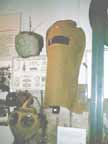
Above is the PH helmet, including the rubber "breather" valve. It seemed to be a fairly thin cotton-linen material, which would be immersed in a chemical solution. It closely resembles the Cluny-Brown gas helmet but the material is different. It was designed to be dipped in the same mix of chemicals as the black gauze or white gauze mouth pads, so it should be slightly porous. The mouth piece seemed to be a one-way valve for disposing of exhaled air and made of leather or similar, resembling an oboe reed. Colin suspects the valve ended in a mouth tube, to reduce problems with steaming up?
Also note how it was much longer, tapered, and designed to be pulled over the shoulders. Uniform design was slightly changed in 1916 to include "gas collars" that could be fixed over the gas helmet.
 |
 |
Both photos above show views of "Black gauze" mouth pad (designed to be soaked in the same sort of chemicals as the PH helmet), gas goggles that could be worn with them, an early smoke helmet, and a box respirator.
The Smoke hood was designed to be dipped in the same mix as the nearby black gauze pad. It had no way to exhale properly and suffered from condensation. The window was of celluloid and cracked easily.
The neighbouring black gauze was a pad of dipped wool held in place by a fishnet stocking and tied round the head. It was more comfortable to wear, and the eyes would be protected by goggles which could not steam up.
The Box Respirator below it was a fabric face piece with a mouthpiece connected by hose to a large chest pack, and a nose pinch to force breathing through the mouth. That basic design was kept until the 1950s or so, as it didn't fog up much, and was apparently rated good for 40 hours usage. It was clumsy, and troops preferred to wear the gauze and goggles if lacrymators were being used. Even though fusing gas shell fuses were often faulty, resulting a fair number of duds, but there was no safe way of knowing what you were receiving, and changing masks mid-way through an attack was a good way of getting a fatal lung-full. Those who witnessed the protection it gave became firm fans of the Box type.
submitted: August 23, 2004 by Colin Fenn